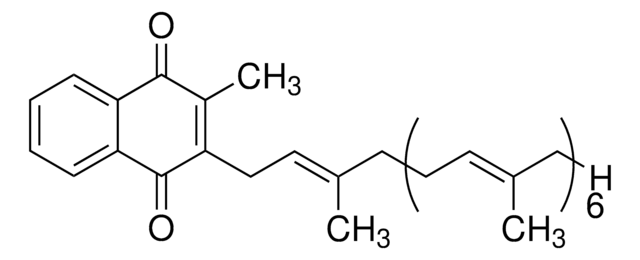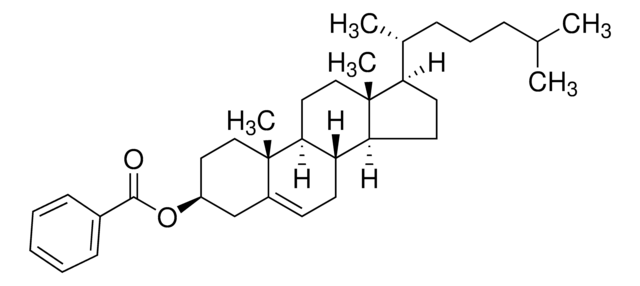1538006
USP
Phytonadione
United States Pharmacopeia (USP) Reference Standard
Sinónimos:
81818-54-4
Iniciar sesiónpara Ver la Fijación de precios por contrato y de la organización
About This Item
Productos recomendados
grado
pharmaceutical primary standard
familia API
phytonadione
fabricante / nombre comercial
USP
aplicaciones
pharmaceutical (small molecule)
Formato
neat
temp. de almacenamiento
2-8°C
Descripción general
This product is provided as delivered and specified by the issuing Pharmacopoeia. All information provided in support of this product, including SDS and any product information leaflets have been developed and issued under the Authority of the issuing Pharmacopoeia.For further information and support please go to the website of the issuing Pharmacopoeia.
Aplicación
Phytonadione USP reference standard, intended for use in specified quality tests and assays as specified in the USP compendia. Also, for use with USP monographs such as:
- Phytonadione Tablets
- Phytonadione Injectable Emulsion
- Oil-Soluble Vitamins Preparation
- Oil-Soluble Vitamins Tablets
- Menaquinone-4
- Oil-Soluble Vitamins Oral Solution
Phytonadione USP reference standard, intended for use in specified quality tests and assays as specified in the USP compendia. Also, for use with USP monographs such as:
- Phytonadione Tablets
- Phytonadione Injectable Emulsion
- Phytonadione Compounded Oral Suspension
- Oil-Soluble Vitamins Preparation
- Oil-Soluble Vitamins Tablets
- Menaquinone-4
Nota de análisis
These products are for test and assay use only. They are not meant for administration to humans or animals and cannot be used to diagnose, treat, or cure diseases of any kind.
Otras notas
Sales restrictions may apply.
Producto relacionado
Referencia del producto
Descripción
Precios
Frases de peligro
Consejos de prudencia
Clasificaciones de peligro
Aquatic Chronic 4
Código de clase de almacenamiento
10 - Combustible liquids
Clase de riesgo para el agua (WGK)
WGK 1
Punto de inflamabilidad (°F)
Not applicable
Punto de inflamabilidad (°C)
Not applicable
Elija entre una de las versiones más recientes:
Certificados de análisis (COA)
Lot/Batch Number
It looks like we've run into a problem, but you can still download Certificates of Analysis from our Documentos section.
Si necesita más asistencia, póngase en contacto con Atención al cliente
¿Ya tiene este producto?
Encuentre la documentación para los productos que ha comprado recientemente en la Biblioteca de documentos.
Los clientes también vieron
Carmela T M Mascio et al.
Antimicrobial agents and chemotherapy, 58(7), 3976-3982 (2014-05-07)
Surotomycin (CB-183,315) is an orally administered, minimally absorbed, selective bactericidal cyclic lipopeptide in phase 3 development for the treatment of Clostridium difficile-associated diarrhea. The aim of this study was to evaluate the emergence of resistance in C. difficile (ATCC 700057
C Rodriguez et al.
Food microbiology, 42, 166-171 (2014-06-16)
Clostridium difficile has been isolated from food animals and meat, specially ground pork and ground beef. The recovered isolates were closely related to C. difficile human strains, indicating that animals and food are possible transmission routes of human C. difficile infection. The
Ji-Hoi Moon et al.
BMC microbiology, 14, 218-218 (2014-08-26)
Polyphosphate (polyP) has bactericidal activity against a gram-negative periodontopathogen Porphyromonas gingivalis, a black-pigmented gram-negative anaerobic rod. However, current knowledge about the mode of action of polyP against P. gingivalis is incomplete. To elucidate the mechanisms of antibacterial action of polyP
C Rodriguez et al.
Veterinary microbiology, 172(1-2), 309-317 (2014-06-05)
Clostridium difficile has been identified as a significant agent of diarrhoea and enterocolitis in both foals and adult horses. Hospitalization, antibiotic therapy or changes in diet may contribute to the development of C. difficile infection. Horses admitted to a care
Hrisi Bahar Tokman et al.
Clinical laboratory, 60(11), 1879-1886 (2015-02-05)
Anaerobic bacteria play an important role in eye infections; however, there is limited epidemiologic data based on the the role of these bacteria in the etiology of keratitis and endophthalmitis. The aim of this re- search is to determine the
Nuestro equipo de científicos tiene experiencia en todas las áreas de investigación: Ciencias de la vida, Ciencia de los materiales, Síntesis química, Cromatografía, Analítica y muchas otras.
Póngase en contacto con el Servicio técnico








